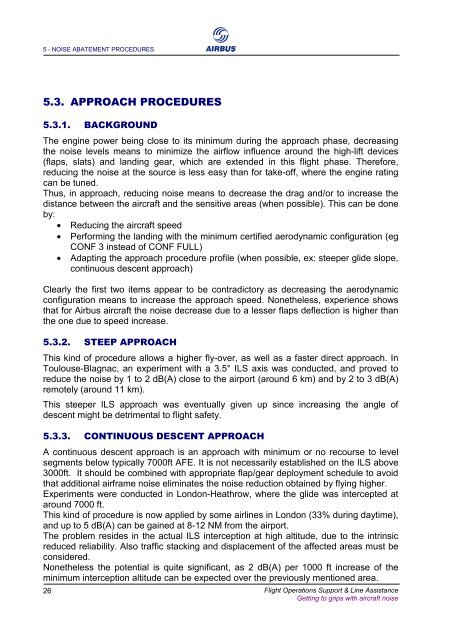Getting to Grips with Aircraft Noise
Getting to Grips with Aircraft Noise
Getting to Grips with Aircraft Noise
You also want an ePaper? Increase the reach of your titles
YUMPU automatically turns print PDFs into web optimized ePapers that Google loves.
5 - NOISE ABATEMENT PROCEDURES<br />
5.3. APPROACH PROCEDURES<br />
5.3.1. BACKGROUND<br />
The engine power being close <strong>to</strong> its minimum during the approach phase, decreasing<br />
the noise levels means <strong>to</strong> minimize the airflow influence around the high-lift devices<br />
(flaps, slats) and landing gear, which are extended in this flight phase. Therefore,<br />
reducing the noise at the source is less easy than for take-off, where the engine rating<br />
can be tuned.<br />
Thus, in approach, reducing noise means <strong>to</strong> decrease the drag and/or <strong>to</strong> increase the<br />
distance between the aircraft and the sensitive areas (when possible). This can be done<br />
by:<br />
• Reducing the aircraft speed<br />
• Performing the landing <strong>with</strong> the minimum certified aerodynamic configuration (eg<br />
CONF 3 instead of CONF FULL)<br />
• Adapting the approach procedure profile (when possible, ex: steeper glide slope,<br />
continuous descent approach)<br />
Clearly the first two items appear <strong>to</strong> be contradic<strong>to</strong>ry as decreasing the aerodynamic<br />
configuration means <strong>to</strong> increase the approach speed. Nonetheless, experience shows<br />
that for Airbus aircraft the noise decrease due <strong>to</strong> a lesser flaps deflection is higher than<br />
the one due <strong>to</strong> speed increase.<br />
5.3.2. STEEP APPROACH<br />
This kind of procedure allows a higher fly-over, as well as a faster direct approach. In<br />
Toulouse-Blagnac, an experiment <strong>with</strong> a 3.5° ILS axis was conducted, and proved <strong>to</strong><br />
reduce the noise by 1 <strong>to</strong> 2 dB(A) close <strong>to</strong> the airport (around 6 km) and by 2 <strong>to</strong> 3 dB(A)<br />
remotely (around 11 km).<br />
This steeper ILS approach was eventually given up since increasing the angle of<br />
descent might be detrimental <strong>to</strong> flight safety.<br />
5.3.3. CONTINUOUS DESCENT APPROACH<br />
A continuous descent approach is an approach <strong>with</strong> minimum or no recourse <strong>to</strong> level<br />
segments below typically 7000ft AFE. It is not necessarily established on the ILS above<br />
3000ft. It should be combined <strong>with</strong> appropriate flap/gear deployment schedule <strong>to</strong> avoid<br />
that additional airframe noise eliminates the noise reduction obtained by flying higher.<br />
Experiments were conducted in London-Heathrow, where the glide was intercepted at<br />
around 7000 ft.<br />
This kind of procedure is now applied by some airlines in London (33% during daytime),<br />
and up <strong>to</strong> 5 dB(A) can be gained at 8-12 NM from the airport.<br />
The problem resides in the actual ILS interception at high altitude, due <strong>to</strong> the intrinsic<br />
reduced reliability. Also traffic stacking and displacement of the affected areas must be<br />
considered.<br />
Nonetheless the potential is quite significant, as 2 dB(A) per 1000 ft increase of the<br />
minimum interception altitude can be expected over the previously mentioned area.<br />
26<br />
Flight Operations Support & Line Assistance<br />
<strong>Getting</strong> <strong>to</strong> grips <strong>with</strong> aircraft noise


